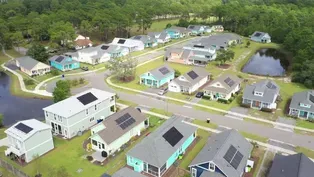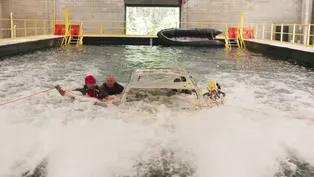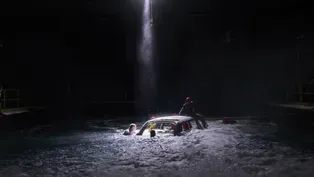
Inside the Electric School Bus Experiment
Clip: 2/7/2025 | 5m 43sVideo has Closed Captions
Cabarrus County schools swap diesel buses for electric fleets, transforming student transportation.
Every day, millions of American children ride diesel-powered school buses, inhaling potentially harmful pollutants. But a change is rapidly unfolding in our school districts. This video takes you inside the high-stakes world of electric school buses – from cutting-edge production lines to the streets of an ambitious county leading the charge.

Inside the Electric School Bus Experiment
Clip: 2/7/2025 | 5m 43sVideo has Closed Captions
Every day, millions of American children ride diesel-powered school buses, inhaling potentially harmful pollutants. But a change is rapidly unfolding in our school districts. This video takes you inside the high-stakes world of electric school buses – from cutting-edge production lines to the streets of an ambitious county leading the charge.
How to Watch ncIMPACT
ncIMPACT is available to stream on pbs.org and the free PBS App, available on iPhone, Apple TV, Android TV, Android smartphones, Amazon Fire TV, Amazon Fire Tablet, Roku, Samsung Smart TV, and Vizio.
Providing Support for PBS.org
Learn Moreabout PBS online sponsorship[light music] - This may be one of the most iconic vehicles in America.
Now, I know that's a bold claim, but if you're anything like me, just looking at one of these things brings back memories.
One of those core memories [inhaling deeply] is the unmistakable smell of exhaust and diesel fuels lingering in the air.
Fast forward to today and little has changed.
Millions of kids across America still hop on these yellow icons daily, inhaling the same harmful fumes we did years ago.
But what if we could change this?
[cars whooshing] We're about to take you on a journey from the busy production lines of a local bus manufacturer to the quiet, clean streets of a county that's trying to forge a more resilient future.
But is turning our yellow buses green the key to cleaner air and a brighter future for our kids, or are we just along for an expensive ride?
I'm David Hurst.
This is "ncIMPACT."
[upbeat music] [machines clicking] School buses have been a staple of American education for decades.
Each year, 450,000 school buses hit the road, driving 3.5 billion, yes, billion, miles.
That is a whole lotta bus stops.
[light music] But 95% of school buses in the US run on diesel, and the EPA considers diesel exhaust one of the most dangerous pollutants to public health, with children being especially vulnerable to its harmful effects.
That bothers Art Whitaker, the transportation director of Cabarrus County Schools.
So when state officials asked him if he wanted to pilot an electric school bus program, he jumped at the opportunity.
Their electric school bus has now been in service since 2021.
- When it's on the school grounds and we're waiting for either arrival or dismissal, the students of Cabarrus County are not actually breathing in any kinda harmful emissions.
- [David] With a range of about 140 miles per charge, the bus works on a fixed route within the city.
- Every power tool that you buy nowadays has a battery behind it, doesn't it?
So not only has the industry, school bus industry has adapted, the industry in regards to battery technology has really been something that myself and a lotta other transportation directors have been really interested in.
[light music] - We then visited this electric school bus' birthplace, Thomas Built Buses in High Point, North Carolina.
They've been making school buses since 1936, but are shifting gears to create the future of school transportation.
It's here on the manufacturing floor where about 15,000 school buses roll off the assembly line each year.
And these iconic yellow bodies you see will actually end up on both electric and diesel buses.
Whether they're building an electric or diesel bus, the basic steps remain the same.
Workers carefully assemble each piece, attaching seats, mirrors, and other familiar parts to the frame.
The main difference, the massive battery that powers the electric versions.
And it's not just the heart of these next-generation buses.
They make up about 40% of the manufacturing cost.
But, perhaps, the most familiar part of the process is watching these buses get their signature yellow coat.
It's a tradition that continues, whether there's a battery or diesel engine underneath.
Now here's the interesting part.
These aren't just buses.
They're mobile power plants.
And during hurricane season, the district used to worry about diesel fuel shortages.
While electric school buses still need to be charged, they do offer a unique advantage.
They can actually serve as backup batteries to power critical facilities during emergencies.
But here's the thing, cost still remains a significant barrier to widespread adoption.
While a traditional diesel bus costs between 100,000 and $150,000, an electric bus can run anywhere from 300,000 to $400,000.
The reason for this price difference really lies in scale and supply chains.
School bus batteries are nearly triple the size of those in passenger cars.
This requires specialized components from a limited pool of suppliers.
While the industry pushes to expand production beyond its current market share, manufacturers believe costs will decrease as the technology becomes more widespread.
- So at 8.8% of the industry today being electrified school buses, there's a lotta more room to grow.
The scale can continue to grow and help drive down those costs for us, as well as our customer.
And that's where we want to go.
We wish that it would be faster, but it's moving in that right direction.
- [David] So while these costs present a significant hurdle, some school districts are finding ways forward through grant funding.
In Cabarrus County, their electric bus came at no cost to taxpayers.
It was funded through a statewide program using North Carolina's $30 million settlement with Volkswagen.
How do you scale that, though?
Is it sustainable to be able to just continually rely on external funds to be able to fund these kinda buses?
- Hopefully what's gonna happen in the period of time that we'll do our analysis, and through that analysis, we can determine our cost savings in regards to whether or not it's economically feasible from a cost standpoint to continue operating the electric.
But at the same time, as everyone knows, as soon as you introduce a product into the market, where hopefully that product becomes cheaper and less expensive as the years go on.
[light music] - And while much about school transportation is evolving, some things likely will never change.
So how soon are we to having this thing drive itself?
[Art and David laughing] - I don't know.
I think that you'll always have to have that- - Yeah.
- Human capital with- - Right, with kids involved.
- With your hands around the wheel.
- Yep.
[bus whirring] [light music] - For "ncIMPACT," I'm David Hurst.
How This Neighborhood is Outsmarting the Power Grid
Video has Closed Captions
Brunswick County turns to microgrids for energy independence amid aging power infrastructure. (7m 22s)
Inside One of America's Most Advanced Water Rescue Training Facilities
Video has Closed Captions
Explore Fayetteville Tech's swift water rescue training facility. (8m 8s)
Preview | Energy and the Environment
Video has Closed Captions
In a storm-ravaged state, communities find ways to save lives and build toward an uncertain future. (30s)
Providing Support for PBS.org
Learn Moreabout PBS online sponsorship













